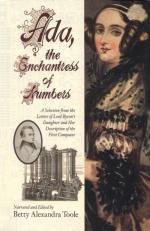|
This section contains 652 words (approx. 3 pages at 300 words per page) |

|
1815-1852
English Mathematician
Augusta Ada Byron, Countess of Lovelace, was a pioneer in the field of computer science. The work she did on a paper describing Charles Babbage's analytical engine revealed her understanding of the machine we now call the computer. Her remarkable insight far exceeded an understanding of the technology available in her lifetime.
In 1815 Augusta Ada Byron was born in London to Annabella Millbanke, an amateur mathematician, and the renowned poet Lord Byron (George Gordon). Byron inherited her father's creative traits and her mother's love of mathematics.
Byron's parents separated soon after her birth, and her mother raised her with the help of private tutors. Byron's tutors fostered her early interest in systems as well as her desire to understand how things operated. Along with traditional subjects, tutors taught the young girl mathematics and astronomy. Math...
|
This section contains 652 words (approx. 3 pages at 300 words per page) |

|


